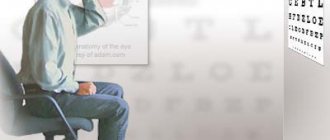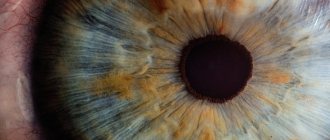Few people would disagree that human life would be impossible without our senses. All of them are important to us, but if you ask a person which one they are least willing to lose, then most likely they will say: eyes.
Eyes are one of the most basic human sense organs. It is thanks to them that we know what the world looks like and we can navigate it. However, the way they function as well as their capabilities are not fully known even today.
People are trying to unravel any mysteries related to the human eye, but there is still a lot to be learned in this regard. What known and unknown capabilities of the human eye might surprise us? We present to you 10 interesting facts about human eyes and vision.
Vision is the main human sense
It has been established that about 80% of information enters the brain through the eyes . Interestingly, people who have lost their sight continue to “see” during sleep. This is achieved by storing images in memory and the ability to create a “new movie” based on previously stored information.
This is not available to people who were born blind because the brain never received any images from the organ of vision that could be processed, remembered, and then used.
Upside down
The image appearing on the retina of the eye appears there inverted and reduced . It is then corrected and converted into information by the brain so that we can perceive it correctly.
Also, it should be noted that the lens in our eye works faster than any photographic lens. Try to quickly look around the room and think about how many different distances you focus your gaze. Each time this happens, the lens constantly changes its focus and all this unconsciously. Compare this to a photographic lens, which takes a few seconds to change focus from one subject distance to another.
Retina of the eye (retina)
The retina is a peripheral part that launches the visual analyzer, which plays an important role in the structure of the human eye. With its help, light waves are captured, converted into impulses at the level of excitation of the nervous system, and further transmission of information is carried out through the optic nerve.
Retina is the nerve tissue that forms the inner lining of the eyeball. It limits the space filled by the vitreous. The outer frame is the choroid. The thickness of the retina is insignificant. The parameter corresponding to the norm is only 281 microns.
The inside surface of the eyeball is mostly covered with retina. The optic disc can be considered the beginning of the retina. Then it stretches to such a border as a jagged line. Then it transforms into pigment epithelium, envelops the inner lining of the ciliary body and spreads to the iris.
The structure of the retina is formed by several layers, differing in different functionality and structure. They are closely connected to each other. A tight contact is formed, causing the creation of what is commonly called a visual analyzer. Through it, a person is given the opportunity to correctly perceive the world around him, when an adequate assessment of the color, shape and size of objects, as well as the distance to them, is made.
When light rays enter the eye, they pass through several refractive media. They should be understood as the cornea, ocular fluid, the transparent body of the lens and the vitreous body. If the refraction is within normal limits, then as a result of such passage of light rays, a picture of objects that fall into the field of view is formed on the retina.
From the point of view of structure, retina is the most complex formation. All its components closely interact with each other. It is multi-layered. Damage to any layer can lead to a negative outcome. Visual perception as a functionality of the retina is provided by a three-neural network that conducts excitations from receptors. Its composition is formed by a wide range of neurons.
Dilation and constriction of pupils
The pupil of the eye reacts to light. It narrows when there is very light around, and expands in the dark . However, it is not only in such situations that its size changes.
At many times when a person experiences specific emotions, the size of the pupil may change. For example, it expands if we experience fear, joy, sexual desire and excitement. Interestingly, the pupil reduces its diameter when a person feels uncomfortable, being strongly depressed by the circumstances around him.
Pupil
The pupil of the eye is a round hole located in the center of the iris. Its diameter can be changed, which allows you to regulate the degree of penetration of the light flux into the inner area of the eye. The muscles of the pupil in the form of a sphincter and a dilator provide conditions when the illumination of the retina changes. The use of the sphincter constricts the pupil, and the dilator dilates it.
This functioning of the mentioned muscles is akin to how the diaphragm of a camera functions. Blinding light leads to a decrease in its diameter, which cuts off too intense light rays. Conditions are created when image quality is achieved. Lack of lighting leads to a different result.
The size of the pupils is adjusted automatically, if such an expression is acceptable. The human consciousness does not explicitly control this process. The manifestation of the pupillary reflex is associated with a change in the illumination of the retina. The absorption of photons starts the process of transmitting the corresponding information, where the recipients are understood as nerve centers.
Pupil reflexes
The reaction in the form of a reflex is ensured due to sensitivity and excitation of motor activity. First, a signal is formed as a response to a certain influence, and the nervous system comes into play. Then follows a specific reaction to the stimulus. Muscle tissue is involved in the work.
Lighting causes the pupil to constrict. This cuts out glare, which has a positive effect on the quality of vision.
- straight – one eye is illuminated. It reacts in the required manner;
- friendly - the second organ of vision is not illuminated, but responds to the light influence exerted on the first eye. This type of effect is achieved by partially intersecting the fibers of the nervous system. A chiasma is formed.
The irritant in the form of light is not the only cause of changes in pupil diameter. Moments such as convergence - stimulation of the activity of the rectus muscles of the visual organ, and accommodation - activation of the ciliary muscle are also possible.
The occurrence of the pupillary reflexes in question occurs when the point of vision stabilization changes: the gaze is transferred from an object located at a great distance to an object located at a closer distance. The proprioceptors of the mentioned muscles are activated, which provide fibers going to the eyeball.
Emotional stress, such as from pain or fear, stimulates pupil dilation. If the trigeminal nerve is irritated, and this indicates low excitability, then a narrowing effect is observed. Also, similar reactions occur when taking certain medications that excite the receptors of the corresponding muscles.
Pirate Eye Patch
The eyes must adapt to the amount of light around it. Often, when we enter a dark room from a light room, we need to wait some time before the eye adjusts and recognizes the surroundings and objects. Also in a situation where we move from a dark interior to a light one.
It was for this reason that pirates wore an eye patch over one eye. It usually closed... the healthy eye, allowing it to quickly adapt to variable lighting conditions . The pirate, going below deck, where there was not enough light, put on an eye patch over his open eye. Thanks to this habit, he could quickly adapt to changes in the degree of illumination of the space without wasting a second on adjusting his eyes.
Eyes
- Eyes with green pigment are the rarest on the planet. Only 2% of the world's inhabitants have this rare eye color.
- Approximately 1% of people have different iris colors in their left and right eyes.
- It is impossible to sneeze with your eyes open (and there is no need to try, this is probably a defensive reaction so that the visual organ is not damaged).
- Every 12th man on the globe is colorblind (probably not completely colorblind, it is simply believed that men are worse at distinguishing colors than women).
- The human eye distinguishes color waves of only three spectrums (red, blue and green).
- The lifespan of each eyelash is on average 5 months.
- “Floaters” (particles that are sometimes visible to the eye) are just shadows on the retina of the eye from the smallest protein filaments located inside the eye.
- “Impossible colors” are very difficult colors for the human eye to perceive.
- When you rub your eyes, flashes of light appear, called phosphenes.
- The human eye is capable of making smooth movements when it follows a moving object.
- Due to the lack of gravity in space, astronauts are unable to cry. The tear fluid collects in small balls.
- To better adapt their vision to the daylight above the deck and the dim light below it, the pirates were forced to use a blindfold. Therefore, one eye saw better below deck, and the other saw better above deck (this is a controversial theory; there is a version that only one-eyed pirates wore the eye patch).
- All newborn children have gray-blue eyes; they acquire a different color only after two years.
- The ancient Arabs tested visual acuity using the starry sky. If in the constellation Ursa Major a small star is clearly visible in the handle of the bucket, not far from the middle star, then the eyes of the beholder have normal sharpness.
- The lightest eye shade among Europeans belongs to the inhabitants of the Baltic states, Finland and Sweden. A larger number of people with dark eye color live in Turkey and Portugal.
The eyes need to rest
The human eye can perform its functions without rest. However, the muscles that are responsible for the movements of the eyeball and eyelids need a break .
If they are tired, people begin to experience great discomfort. Because of this, symptoms may subsequently develop that interfere with good vision. The eyes begin to burn, water, or there is a feeling of “heavy eyelids” and even a headache. This is a signal that it's time to rest your eyes.
Just about health: the most important questions about eye health
According to various sociological surveys, the vast majority of respondents are afraid of losing their sight with age. And not without reason - we receive up to 80% of information through vision. What are the most important things you need to know about his health and how to maintain it, Sputnik looked into it.
In fact, we see thanks to the brain - the eyes are just windows. And if a person loses vision, the parts of the brain that are involved in processing visual information begin to atrophy over time.
How does the eye work?
To understand how the eye works, you need to know how it works.
The eye is located in the socket of the skull. Eyelids and eyelashes protect it from dust, eyebrows divert moisture flowing from the forehead. Tears moisten the outer part of the eyeball and wash away foreign particles.
The outer layer of the eye is the dense sclera. In the front part it is transparent and is called the cornea. The cornea allows light rays to pass through freely.
The vascular anterior part of the tunica media is called the iris. This is our light filter, its color is the color of our eyes. It is influenced by ethnic characteristics that are formed under the influence of the surrounding nature. You will never meet a black man with blue eyes, because in Africa, where his ancestors lived, there is a lot of bright light and solar radiation - the eye has adapted to secrete a dark protective pigment, and this is fixed genetically.
Chabacano
Structure of the human eye
And in Scandinavian countries people have blue eyes - there is a lack of sunlight there. Residents of the extreme server, for example, the Yakuts, have their own characteristics - their eyelashes are structured differently. They are not twisted, like those of Europeans, but are lowered down - this is how they protect the eye from the sun reflected from the snow, which is hundreds of times more dangerous than usual.
The pupil is located in the center of the iris. Through it, light enters the inner layer of the eye - the retina. Our pupil can be compared to the aperture of a camera. When there is a lot of light, it narrows due to the muscular apparatus; if there is little light, the pupil dilates. Through the pupil, light enters the biconvex lens and the retina of the eye.
Important.
It is dangerous to use sunglasses without special filters, and when wearing such glasses while driving in sunny weather, this can lead to blindness - a person receives a double dose of solar radiation. Since the windshield is a lens, it transmits and amplifies solar radiation, and in dark glasses without a filter, the pupil dilates, and strong irradiation occurs on the retina, essentially burning out cells. When the pupil is dilated due to dark glasses, the area of damage to the retina increases.
The lens is a living lens, and thanks to muscles it can change its curvature so that we can clearly see objects both near and far.
The retina is part of the human nervous system. It is here that in several layers of neurons, light is converted into bioelectrical vibrations and their path along the optic nerve to the brain begins.
The main role in the transformation of light is played by 2 types of receptors: rods (responsible for colorless, twilight, vision in the dark) and cones (responsible for the perception of daylight). Vitamin A helps convert light energy into bioelectric energy, so you need to approach your diet responsibly.
Important.
With a lack of vitamin A, a person ceases to see well in the twilight (the rods die), his vision becomes similar to the vision of a pigeon or chicken. The so-called night blindness is formed - predominantly cone vision.
Cones play a major role in daytime color vision. They have their own pigment, which is each sensitive to its own color. The different combinations of variations of these cone pigments allow us to see a wide range of colors.
It happens that a person’s color perception is impaired, and then he sees the world a little differently than everyone else. This is color blindness. It can be congenital, less often - acquired. This visual defect is interesting for artists, but dangerous for drivers.
How does the visual apparatus mature?
Newborns see the world upside down and blurry. Only thanks to the constant work of the brain, over time, everything returns to normal. The visual system matures with us. In children, the lens has a light blue tint; in middle age it begins to turn yellow. But in old age, the lens may become brown and lose its elasticity. With age, it becomes flat, and this makes old people see nearby objects blurred. This is called farsightedness.
With myopia, on the contrary, the lens is convex, and objects blur when looking into the distance. Such vision defects can be easily compensated for by glasses; in particularly difficult cases, surgical intervention will be required.
What harms our eyes?
One of the most serious threats is the active sun. Therefore, it is so important to choose the right glasses and use them not for image, but for protection.
Sunglass lenses should be dark green to smoky or brown, but must have UV filters. You cannot use sunglasses with dark lenses indoors - the eye strains, it constantly strives to dilate the pupil in order to receive photons of light onto the retina. The eye muscles get tired. Such fatigue will lead to a sad outcome over time. It is very undesirable to use glasses with red lenses - you can go blind. Light transformed through bright blue glass depresses the central nervous system.
© Pixabay
Sunglasses must have UV filters
Children should also wear sunglasses. This is especially important when there is reflected sun - there is a danger of harming not only the eye, but also the brain.
How to use gadgets without damaging your eyesight?
TV must be viewed at a distance of five screen diagonals. And if it’s evening, you need to turn on the lights. Otherwise, the eye is constantly overstrained. It is surrounded by a dark space, and you need to focus on bright light. And when we move our gaze, light breakdowns are formed on the retina of the eye. The rods and cones on the retina die. And the nuance is that they are not restored. This leads to vision loss over time.
The same applies to working on a computer. You cannot sit at it in a dark room; the monitor screen must be at eye level and at a sufficient distance. Place monitors on stands.
What other habitual actions harm our eyes?
It is strictly forbidden to read in a moving vehicle, because the eye does not have time or has difficulty adjusting to small vibrations; this enormously strains the muscles that hold the lens. Over time, myopia or farsightedness occurs.
© Pixabay
Just about health: the liver is the main laboratory of the body
You cannot read in poor lighting or in the toilet - this is a physiologically incorrect position for reading, where it is important to focus on something else.
You should not read while eating, because when a person chews, small oscillatory movements of the jaw and head occur, as a result of which the eye muscles are overstrained.
When reading, the light should come from the left, and it should be a regular incandescent light bulb, since a fluorescent lamp does not have the full required color rendition. It will be difficult for the brain to adapt color distortions, which can sometimes cause headaches.
Important.
We should always take care of our eyes - they do not show symptoms of ill health, and we will be able to understand that something is wrong when it is already difficult to change something. The problem is that we do not feel all the light damage to the eyes, like a skin burn.
The capillary network of the eye consists of the smallest and finest vessels. With any deterioration in cerebral circulation, the blood vessels of the eyes will suffer. Therefore, it is so important to ensure good blood supply to the eyeball - oxygen and nutrients are carried with the blood, and toxins and carbon dioxide are eliminated.
You cannot sleep on a high pillow, when the neck is curved, the blood supply to the eye changes. Therefore, sometimes after sleep a hemorrhage is detected on the retina. Sleeping on your stomach is also not safe for your eyes. It is best to sleep on your back with the right orthopedic pillow.
© Pixabay
Just about health: what does blood pressure signal?
Do not rub your eyes with dirty hands or work in dusty areas without protection. Eyes recover very poorly from chemical and physical damage.
When should you wear glasses, and are they necessary at all?
From a physiological standpoint, glasses are crutches for the eyes. They help a person see, rather than restore vision.
With myopia, for example, a person has difficulty seeing into the distance. Normally, the muscles stretch the lens, its curvature changes, and objects come closer. And if the muscles fail, vision decreases. Glasses use lenses to correct the position of an object.
But glasses cannot be worn all the time - so that the muscular system does not suffer from long-term static tension, this destroys the muscles, they become atonic.
Wearing glasses incorrectly further worsens vision loss. Glasses (lenses) refract sunlight, which further damages the retina. Therefore, over time, a person who wears glasses needs more and more correction - the diopters in his glasses increase, and his vision worsens. Therefore, it is advisable to remove glasses when there is no need to examine the smallest details. Muscles need training (vision without glasses) and rest. It is also advisable for people with myopia to wear glasses with tinting or chameleon lenses that darken in bright light.
© Sputnik / Alexander Kryazhev
How to take vitamins correctly: 9 answers to current questions
Can vision improve with age?
Closer to forty years, the human body begins to retain moisture worse. The first thing in the body to suffer from this is the lens. The lens is also a water-filled structure; lack of water, poor blood circulation (thick, oily, viscous blood) leads to the fact that the lens becomes less elastic (tight), and it is difficult for the muscles to stretch it. This situation can be taken advantage of positively.
If you are nearsighted, you should take off your glasses at least periodically, for example, in the evenings. Vision physiologically will begin to change towards farsightedness, and a “plus” to a “minus” can lead to normalization of vision.
Beta-carotene is very important for vision. It is involved in color rendering. It produces vitamin A, the pigment rhodopsin (visual purple), which activates rods and cones for light and color transmission.
What is astigmatism?
Another type of vision change is astigmatism. When both eyes convey a different image, and it is difficult for the brain to combine and analyze it, as a result, the sharpness of vision decreases.
© Pixabay
Just about health: the most important questions about female beauty
How can changing teeth ruin your vision?
Both astigmatism and strabismus can be associated with different eyeball sizes or skull structure. The eyes have a special location - they are in an orbit that is clearly adapted to the eye. It is formed by 8 bones of the skull. And here every little thing can be important. For example, if a person falls and hits his forehead, his frontal bone may move; if he hits his temple or often sleeps on it, there will be microdeformation in this area. These are significant changes for the eye. Sinusitis and improperly growing teeth can affect the orbit of the eye.
Children often experience deformities when their teeth change, and larger permanent ones begin to erupt instead of small milk teeth. If the teeth are crooked, the bone skeleton of the upper jaw begins to deform, and the eye sockets may change size and may shift relative to each other.
Any unnoticeable deformations of the maxillofacial skeleton lead to vision problems. In such cases, you need to consult an orthopedist and x-ray the eye sinuses!
© Pixabay
How are joint problems and pH related?
Important.
When children change teeth, it is important to monitor their vision. If your child’s vision begins to decrease, take him to the orthodontist. Ask your child about his vision more often - the child may feel worsening and simply forget to tell you about it.
Why is it important to drink enough fluids for your vision?
Blood quality is very important for vision. The microcirculation of the ocular apparatus depends on this. If the blood is thick, then the retina of the eye does not receive oxygen in the required volume, and sometimes the cells of the eye begin to change or die. Over time, such blood mechanically clogs the capillaries, which leads to a number of problems and blindness. Therefore, you should always maintain a drinking balance; teas with eyebright help a lot.
The health of vision is influenced by the condition of the whole organism. Healthy blood vessels, proper liver function, and body microflora are important for the eyes (chlamydia, for example, has a detrimental effect on vision - Sputnik). Good tone is also very important for the eyes, and you can maintain it with the help of special gymnastics.
Don't forget to take care of your eyes and enjoy the world in all its colors!
Changes in eye color in babies
A feature that may surprise new parents is that children are not always left with the same eye color they were born with . It is typical for our climate that newborns often come into the world with blue eyes, while for some it darkens over time. Sometimes you need to wait several years to see the real color of the child’s eyes - it may later turn out that his eyes are not blue, but green or brown.
This is due to the production of melanin, which is found in the iris, which gives color to our eyes. In our climate, its production does not begin immediately after the child comes into this world, but after some time, it can affect the change in eye color.
Interestingly, there are no two identical eyes in the world. Each iris, like fingerprints, has its own original and unique pattern. Differences can even be seen between the right and left eyes of the same person. Even identical twins do not have identical irises.
It is also difficult to believe that all blue-eyed people descended from one distant ancestor. Scientists have found that all of our blue-eyed contemporaries trace their origins to one forefather, who most likely lived about 10 thousand years ago in the Black Sea region.
Researchers studying the genetics of eye color have found that more than 99.5% of blue-eyed people who consented to have their DNA studied have the same small mutation in the gene that determines iris color. This, according to Professor Hans Eiberg and his colleagues from the University of Copenhagen, suggests that this mutation originally occurred in just one person, who became the ancestor of all blue-eyed people in future generations.
Night vision correction
Few people know that during night sleep you can completely correct your vision defect . Thanks to this method, in the morning, after waking up, a person can see clearly without wearing glasses. And all this thanks to one of the modern methods called orthocorrection.
The whole secret of this method lies in special orthokeratological lenses that must be worn at night. During sleep, they model the eye and shape the cornea so that it can see clearly for about 10 hours from the moment the lenses are removed.
With the help of orthocorrection, vision defects such as myopia and slight astigmatism can be corrected. And at the same time, this is a completely non-invasive method - the eye returns to its original shape after using the lenses.
Red eye effect
Those who like to take photographs have, of course, more than once encountered the red eye effect , which can ruin even the most successful shot. In fact, this is a side effect of using flash in a dark room or at night.
At the moment of shooting, the flash light hits the eyeball, or rather the pupil, which is dilated in the dark. As a result, it does not have time to decrease and allows a large amount of light into the eyes, which, after being reflected from the retina and passing through numerous blood vessels, gives a red color.
0 0
Structure of the eye
- The most active muscles in the human body are the muscles that control the eyes.
- The eyeball remains the same size as at birth, while the ears and nose grow throughout life.
- Only 1/6 of the eye is visible.
- The iris of the eye has 256 unique features. In comparison, fingerprints have only 40 of these unique properties. Therefore, an image of the iris is used for personal identification.
- Blinking occurs thanks to the fastest muscle in the body and lasts only 100 – 150 milliseconds. The phraseology “you won’t even have time to blink your eye” is justified, since in one second you can blink up to 5 times.
- It is estimated that the average eye blinks 17 times per minute, 14,280 times per day, and the human eye blinks approximately 5.2 million times per year.
- Over the course of an hour, the eye views up to 36 thousand pieces of various visual information.
- Every second the human eye focuses on 50 objects.
- The weight of a healthy person's eye is about 8 grams, its diameter is 24 millimeters.
- The human eye can distinguish 500 shades of gray.
- One eye contains 107 million light-sensitive cells.
- The pupil of the eye contracts in bright light, which helps protect the retina from sunburn, and in the dark the pupil dilates.











